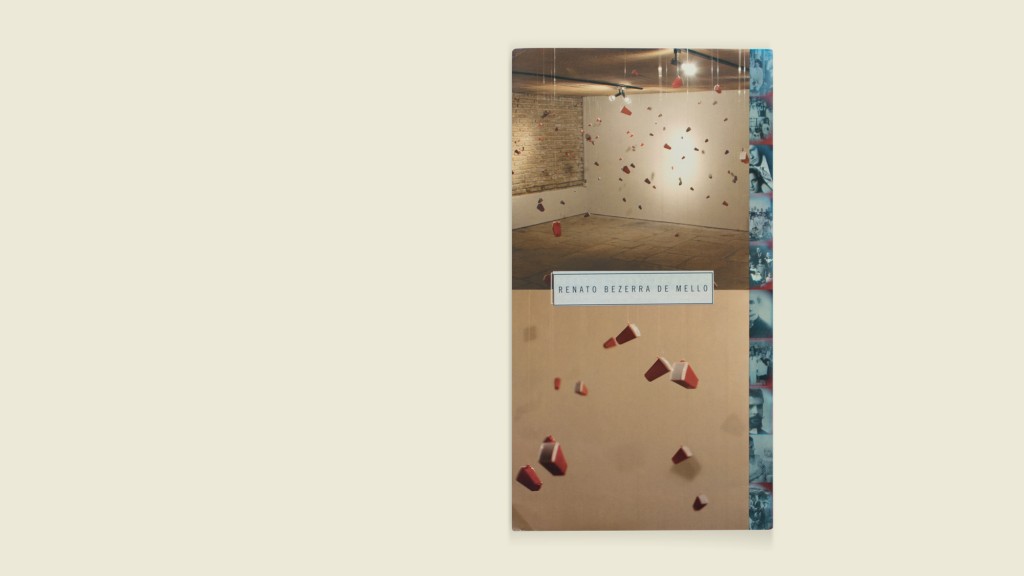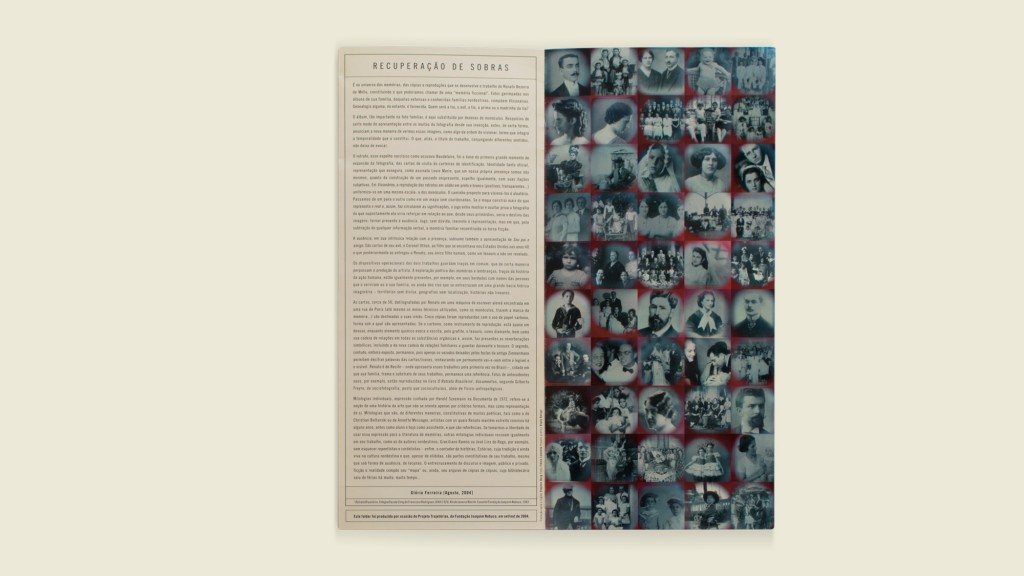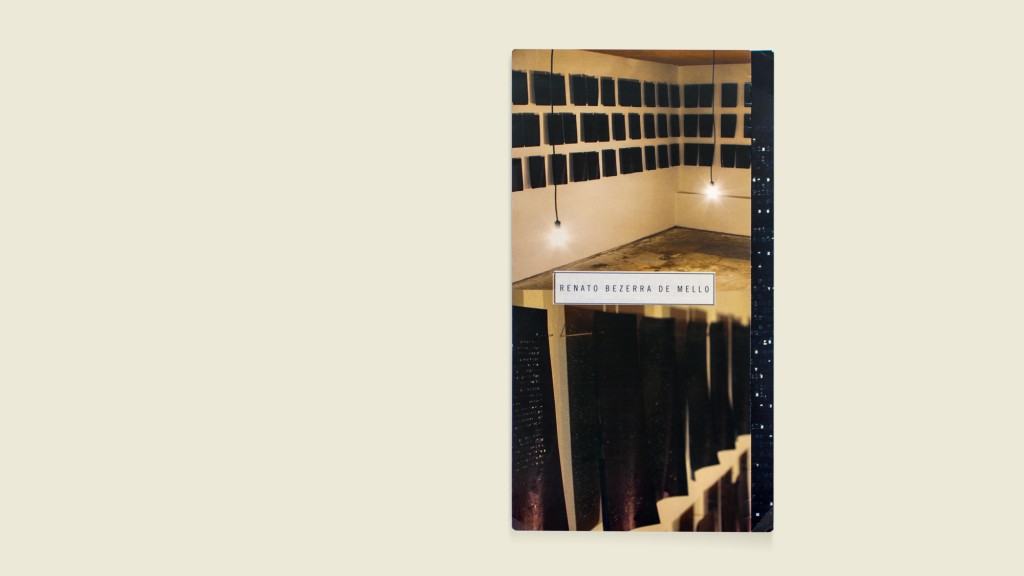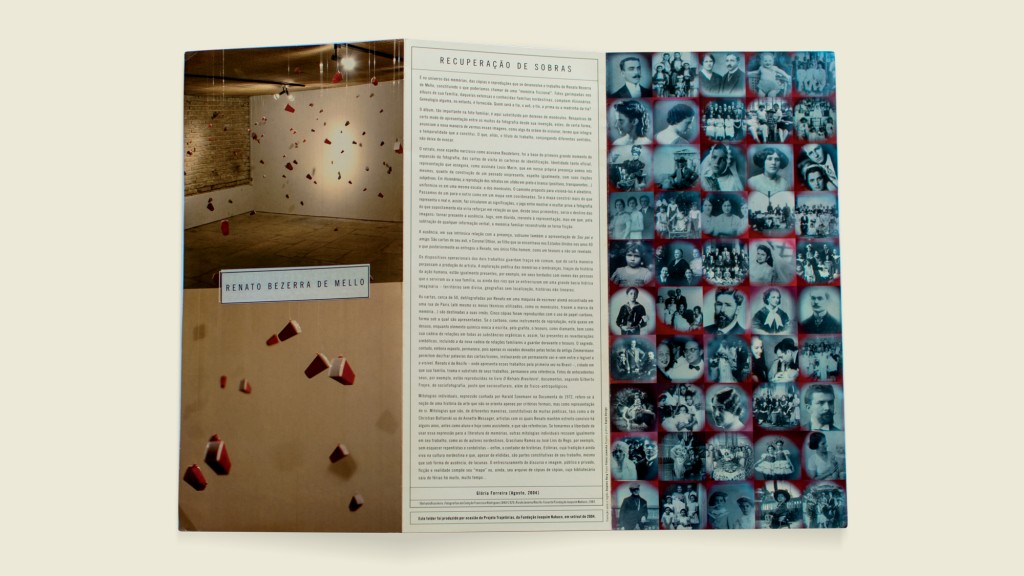TRAJETÓRIAS 4 | 2004
Fundação Joaquim Nabuco, Recife, Brasil
Selection committe: Cristiana Tejo; Daniela Bousso; Moacir dos Anjos


Description of works

1- I am father and friend | 2004
Breaking a pledge to secrecy, I typed five copies of originally typewritten letters that my grandfather had sent my father in the late 1940s, and gave them to my sisters. A sound piece, in an incantatory rhythm, evokes the way my grandfather signed off his letters: “I am father and friend,” which is also the title of this work.
- typewritten sheets of carbon paper , needles, sound
- variable dimensions
- EXHIBITIONS: 'Alcova’, Galeria Laura Marsiaj, Rio de Janeiro, Brasil
- acesse aqui pagina da obra

2 - Visionaries | 2002
For this work I brought characters from family stories and legends into the ordinary world of viewers by recollecting and reproducing black and white slides of old photographs from a variety of sources: from the earliest photography studios of Brazilian portrait artists all the way through to amateur images from the start of the twentieth century.
- series: three installations with 225 viewers each + 1 AP
- plastic viewers and B/W slides
- variable dimensions
- EXHIBITIONS: 'Achados e perdidos’, Sesc Pinheiros, São Paulo, Brasil / ‘Vuelvo al Sur’, L’été Photographique, Centre de Photographie de Lectoure , França / ‘Première vue’, Passage de Retz, Paris, França
- acesse aqui a pagina da obra
Text
REMNANT RECOVERY
Glória Ferreira
Agosto, 2004
Renato Bezerra de Mello carries out his work within a universe of memories, copies and reproductions, making up something we might call a “fictional memory”. The artist comes from a large, well-known Northeastern Brazilian family, and Visionaries is composed of photographs prospected from his family albums. No genealogy is provided, however. Who is the aunt, the grandfather, the cousin, the aunt’s godmother? Of great importance to family photographs, the album is substituted here by dozens of monocles. Vestiges of a certain mode of presentation from among the many photography has had since its invention, they somehow announce a new way of seeing these images, as though they belonged to the order of envisioning, a term which both integrates and constitutes temporality – something that, in its conjugation of meanings, the title of the work never ceases to evoke.
Renato Bezerra de Mello carries out his work within a universe of memories, copies and reproductions, making up something we might call a “fictional memory”. The artist comes from a large, well-known Northeastern Brazilian family, and Visionaries is composed of photographs prospected from his family albums. No genealogy is provided, however. Who is the aunt, the grandfather, the cousin, the aunt’s godmother? Of great importance to family photographs, the album is substituted here by dozens of monocles. Vestiges of a certain mode of presentation from among the many photography has had since its invention, they somehow announce a new way of seeing these images, as though they belonged to the order of envisioning, a term which both integrates and constitutes temporality – something that, in its conjugation of meanings, the title of the work never ceases to evoke.
The portrait Baudelaire called a ‘narcissistic mirror’ was the basis for photography’s first great moment of expansion, on everything from visiting cards to identification cards. An identification that is official (a representation which insures that, as Louis Morin points out to us, in our own presence we are ourselves) and that constructs an omnipresent past (likewise a mirror, with its subjective inferences). In Visionaries, the reproduction of portraits in black and white slides (positive, transparent…) homogenizes them on an equal scale – that of monocles. The way proposed for viewing them is random. We move from one to another as if across a map devoid of coordinates. If maps construct more than reality represents, thus allowing meaning to circulate, the play between showing and hiding deprives photography of that which it would ostensibly reinforce about what, from its dawn, would be the fate of images: making absence present. No doubt a game inherent to representation, albeit one in which, through the subtraction of all verbal information, the reconstructed, familiar memory becomes fiction.
In its intricate relationship with presence, absence also subsumes the presentation of I am both father and friend. These are letters from the artist’s grandfather, Colonel Othon, to a son who was away in the United States during the 1940s and who subsequently gave them to Renato, his only son, as a treasure never to be disclosed. The operational device of both works shares common features which, in a way, permeate the artist’s production. The poetic investigation of memory and recollection, as well as traces of the history of human action are equally present, for instance, in his embroideries of the names of people who served him or his family, or even of intersecting rivers in an imaginary river basin – boundary-less territories, geographies without location, non-linear histories.
The fifty or so letters, typewritten by Renato on a German typewriter that he found on a Parisian street (like the monocles, even the technical means which the artist has found bear the mark of memory…) are addressed to his sisters. Five copies have been reproduced through the use of carbon paper, the form under which they are presented. If, as an instrument of reproduction, carbon has fallen into near-disuse, as a graphic element it evokes writing, through graphite, and treasure, as diamond, as well as its chain of relationships in all organic substances, thus rendering symbolic reverberations present, including those of the new chain of relatives who will look after the treasures from now on
However, although it has been revealed, the secret remains, where the keys of the old Zimmermann have punched through to allow us to decipher the words of the letters/icons, establishing a permanent back and forth movement between the legible and the visible. Renato hails from Recife – where he is presenting these works for the first time in Brazil – a city in which his family, the frame and substratum of his work, remains a reference.
Photographs of his ancestors, for instance, are reproduced in the book O Retrato Brasileiro [The Brazilian Portrait]. According to Gilberto Freyre, they are documents of socio-photography, since they are socio-cultural as well as physical and anthropological.
Individual mythologies – a term coined by Harald Szeemann at the 1972 Documenta – refers to a concept of the history of art not exclusively guided by formal criteria, but as a representation of itself. Mythologies that are, in different ways, constitutive of many poetics, such as those of Christian Boltanski or Annette Messager, artists with whom Renato has worked closely for some years, first as a student and currently as an assistant, both of them references
If we take the liberty to apply this expression to the genre memoir, other individual mythologies resonate equally in his work, such as those of [Brazilian] Northeastern writers Graciliano Ramos and José Lins do Rego, for instance, not to mention the repentistas and cordelistas[1] – all, ultimately, storytellers whose tradition lives on in Northeastern culture and which, despite their elision, are constituent parts of his work, even as absence, or lacunae. The crisscrossing of discourse and image, public and private, fiction and reality compose his “map” or his archive of copies of copies, whose librarian went on vacation a long, long time ago…
[1] Repentistas and cordelistas are, respectively, musical duelists and storytellers, performers who sing and writers who hawk their rhymed stories in marketplaces throughout the Brazilian Northeast.



